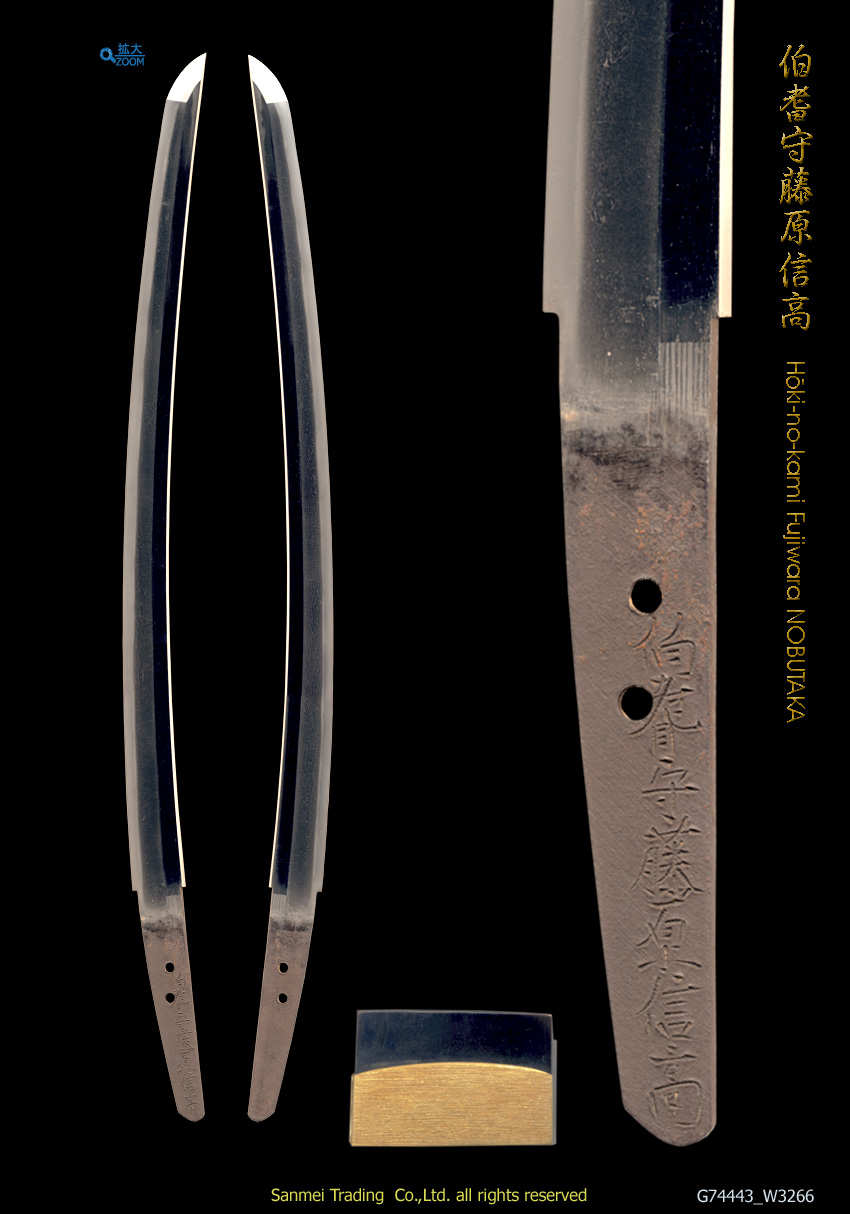Length of cutting edge52.3cm Curvature1.6cm Width of base33.6mm Thickness of base7.2mm Width of Yokote21.7mm
Forging(Hada): Forging is conspicuous Itame wooden grain mixing in with Mokume burl. There shows streaming Masame ware along tempering boundary line. The highlight i s lively Chikei-scene where sparkling Ji-nie metal glitter covers on hiraji-surface that generates energetic Nie-lines.
Temper(Hamon): Hamon is wide Suguha straight, Ko-nie based of which temper line activates with Uchinoke fray, frequent Ashi feet and floating YOU activity and Sunagashi short lines of Nie appears in the interior of temper.
Temper of tip(Boshi): Boshi is small circle turns back deeply to the back ridge.
Tang(Nakago): UBU in original, Two peg holes. Greatly Slanting left with horizontal Kesho filemarks. Uneven U-shape bottom heel. Round back ridge. The signature on omote starts with an official district Hōki-no-kami 伯耆守 title granted by the Imperial Court, the name of clan Fujiwara 藤原 and the smith name NOBUTAKA 信高.
The smith Kawamura San-no-sho NOBUTAKA 河村三之丞信高, who was born in the 9th year of Kanei (1632) in Nagoya, Owari enjoyed Hōki-no-kami 伯耆守 title when he was 34 years old in the 5th day, 3rd month, the 5th year of Kanbun (1665).
Also he became an exclusive sword maker to work for Owari Tokugawa domain under the second feudal lord Tokugawa Mitsutomo in the 5th month, the same year of kanbun 1665.
During Kanbun/Enpo period in the middle of 17th century, there was large demand of swords from Samurais, who preferred stout and best cutting performing blades especially in Owari where Bushido was very vigorous.
The smith Nobutaka proudly worked for a Bushido instructor of Owari Tokugawa, Yagyu Renya Shigekane 柳生連也厳包 and have been prized by Samurais from long ago for their cutting ability as Waza-mono (Sharp cutting performance).
The subject wakizashi is very stout and heavy on hand with wide in mihaba on base and thick in kasane holding a rather on deeper curve. Froging scene is lively vibrant with rich activity of Itame hada and Mokume with Ji-nie that glitters in the light, that has close resembles to the work of NORISHIGE-hada.
The subject wakizashi is a typical example of works which had been owed and treasured by Owari Samurais holding warlike brave spirit and is convincing that the 3rd smith Nobutaka was particularly skilled to meet with their requirement.
Nakago holds a good taste of patina to remain clear filemark and chisel of inscription.
Gold foiled Owari-style habaki collar (Upper shell is gold foiled/lower one is copper alloy shakudo), Preserved in a Shira-Saya plain wood mounting.
An old good polish/Condition scale: very good (using a scale of mint-excellent-very good-good-fair-poor).
reference data:
[Owari Tōkōfu] Iwata Atou 1985 Publisher : Nagoya city Board of Education
[Token Bijutsu vol.357] Kato Hiroshi 1986 Japan Sword Preservation Society


